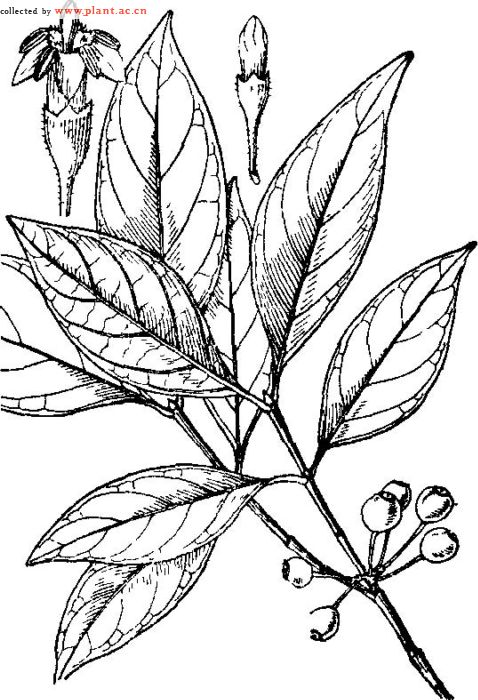香楠Aidia canthioides (Champ. ex Benth.) Masam.
香楠Aidia canthioides (Champ. ex Benth.) Masam.
5. 香楠(海南)水棉木(广西植物名录)、台北茜草树(台湾植物志)图版92:1-7
Aidia canthioides (Champ. ex Benth.) Masam. in Trans. Nat. Hist. Soc. Formosa 28: 118. 1938; Yamazaki in Journ. Jap. Bot. 45: 338. 1970. ——Randia canthioides Champ. ex Benth. in Journ. Bot. Kew Misc. 4: 194. 1852; Benth. Fl. Hongk. 155. 1861; Hemsl. in Journ. Linn. Soc. Bot. 23: 381. 1888; Pitard in Lecomte, Fl. Gen. Indo-Chine 3: 240. 1923; Merr. in Lingnan Sci. Journ. 5: 174. 1927. Kanehira, Formos. Trees ed. 2. 680, fig. 634. 1936; Li, Woody Fl. Taiwan 869. 1963; 海南植物志3: 323. 1974; 中国高等植物图鉴4: 235, 图5884. 1975; J. M. Chao in Li, Fl. Taiwan 4: 330. 1978.
无刺灌木或乔木,高1-12米;枝无毛。叶纸质或薄革质,对生,长圆状椭圆形、长圆状披针形或披针形,长4.5-18.5厘米,宽2-8厘米,顶端渐尖至尾状渐尖,有时短尖,基部阔楔形或有时稍圆,亦有时稍不等侧,两面无毛,下面脉腋内常有小窝孔;侧脉3-7对,在下面明显,在上面平或稍凹下;叶柄长5-18毫米;托叶阔三角形,长3-8毫米,顶端短或长尖,脱落。聚伞花序腋生,长2-3厘米,宽3-5厘米,有花数朵至十余朵,紧缩成伞形花序状;总花梗极短或近无;苞片和小苞片卵形,基部合生成一小杯状体;花梗柔弱,长5-16毫米,无毛;花萼外面被紧贴的锈色疏柔毛,萼管陀螺形,长4-6毫米,宽约4毫米,萼檐稍扩大,顶端5裂,裂片三角形,长1-2毫米,顶端尖;花冠高脚碟形,白色或黄白色,外面无毛,喉部被长柔毛,冠管圆筒形,长8-10毫米,宽约2.5毫米,花冠裂片5,长圆形,长4-7毫米,顶端短尖,开放时外反;花丝极短,花药伸出,长约3.5毫米;子房2室,花柱长约10毫米,柱头纺锤形,长约3毫米,有槽纹。浆果球形,直径5-8毫米,有紧贴的锈色疏毛或无毛,顶端有环状的萼檐残迹,果柄柔弱,长5-17毫米;种子6-7颗,压扁,有棱。花期4-6月,果期5月至翌年2月。
产于福建、台湾、广东、香港、广西、海南、云南;生于海拔50-1500米处的山坡、山谷溪边、丘陵的灌丛中或林中。国外分布于日本和越南。模式标本采自香港。
《Flora of China》 Vol. 19 (2011)
Aidia canthioides (Champion ex Bentham) Masamune Trans. Nat. Hist. Soc. Formosa. 28: 118. 1938.
香楠 xiang nan
Randia canthioides Champion ex Bentham, Hooker’s J. Bot. Kew Gard. Misc. 4: 194. 1852; Aidia canthioides var. lanceolata Masamune; Benkara canthioides (Champion ex Bentham) Ridsdale; Fagerlindia canthioides (Champion ex Bentham) Ridsdale.
Shrubs or trees, 1-12 m tall; branches flattened to subterete, glabrous. Petiole 5-18 mm, glabrous; leaf blade drying papery or thinly leathery, oblong-elliptic, oblong-lanceolate, or lanceolate, 4.5-18.5 × 2-8 cm, both surfaces glabrous, base cuneate to obtuse or shortly rounded, sometimes inequilateral, apex acute to acuminate; secondary veins 3-7 pairs, in abaxial axils usually with foveolate and/or pilosulous domatia; stipules deciduous or sometimes persistent on distalmost nodes, broadly triangular, 3-8 mm, glabrous, apex acute or acuminate. Inflorescences fasciculate or shortly congested-monochasial and subsessile, 2-3 × 3-5 cm, several flowered, glabrescent; bracts ovate, often fused in pairs, 0.5-1 mm, acute to obtuse; pedicels 5-17 mm. Calyx densely to sparsely strigillose; ovary portion obconic, 1-1.5 mm; limb with basal tubular portion 3-5 mm; lobes 5, triangular to deltoid, 0.5-2 mm, acute. Corolla white or yellowish white, glabrous outside; tube 8-9 mm; lobes 5, narrowly spatulate-oblong, 4-7 mm, acute. Berry 5-8 mm in diam., sparsely strigillose or glabrous; seeds 6 or 7, flattened, angled, 2-3 mm. Fl. Apr-Jun, fr. May-Feb.
Thickets or forests on hills, on mountain slopes, or at streamsides in valleys; below 100-1500 m. Fujian, Guangdong, Guangxi, Hainan, Taiwan, Yunnan [Japan, Vietnam].
This species was excluded from Aidia and treated as Fagerlindia canthioides by Ridsdale (Blumea 41: 176. 1996), then as Benkara canthioides by Ridsdale (Reinwardtia 12: 289. 2008). This species is here included in Aidia because of its apparent lack of lateral short shoots or spines, inflorescences not terminal on developed stems, and apparently bisexual flowers.This species was excluded from Aidia and treated as Fagerlindia canthioides by Ridsdale (Blumea 41: 176. 1996), then as Benkara canthioides by Ridsdale (Reinwardtia 12: 289. 2008). This species is here included in Aidia because of its apparent lack of lateral short shoots or spines, inflorescences not terminal on developed stems, and apparently bisexual flowers.
别名:台北茜草树;水黄皮;台北茜草;水棉木;山黄皮;光叶山黄皮;
科名:茜草科 Rubiaceae
属名:茜树属 Aidia

5. 香楠(海南)水棉木(广西植物名录)、台北茜草树(台湾植物志)图版92:1-7
Aidia canthioides (Champ. ex Benth.) Masam. in Trans. Nat. Hist. Soc. Formosa 28: 118. 1938; Yamazaki in Journ. Jap. Bot. 45: 338. 1970. ——Randia canthioides Champ. ex Benth. in Journ. Bot. Kew Misc. 4: 194. 1852; Benth. Fl. Hongk. 155. 1861; Hemsl. in Journ. Linn. Soc. Bot. 23: 381. 1888; Pitard in Lecomte, Fl. Gen. Indo-Chine 3: 240. 1923; Merr. in Lingnan Sci. Journ. 5: 174. 1927. Kanehira, Formos. Trees ed. 2. 680, fig. 634. 1936; Li, Woody Fl. Taiwan 869. 1963; 海南植物志3: 323. 1974; 中国高等植物图鉴4: 235, 图5884. 1975; J. M. Chao in Li, Fl. Taiwan 4: 330. 1978.
无刺灌木或乔木,高1-12米;枝无毛。叶纸质或薄革质,对生,长圆状椭圆形、长圆状披针形或披针形,长4.5-18.5厘米,宽2-8厘米,顶端渐尖至尾状渐尖,有时短尖,基部阔楔形或有时稍圆,亦有时稍不等侧,两面无毛,下面脉腋内常有小窝孔;侧脉3-7对,在下面明显,在上面平或稍凹下;叶柄长5-18毫米;托叶阔三角形,长3-8毫米,顶端短或长尖,脱落。聚伞花序腋生,长2-3厘米,宽3-5厘米,有花数朵至十余朵,紧缩成伞形花序状;总花梗极短或近无;苞片和小苞片卵形,基部合生成一小杯状体;花梗柔弱,长5-16毫米,无毛;花萼外面被紧贴的锈色疏柔毛,萼管陀螺形,长4-6毫米,宽约4毫米,萼檐稍扩大,顶端5裂,裂片三角形,长1-2毫米,顶端尖;花冠高脚碟形,白色或黄白色,外面无毛,喉部被长柔毛,冠管圆筒形,长8-10毫米,宽约2.5毫米,花冠裂片5,长圆形,长4-7毫米,顶端短尖,开放时外反;花丝极短,花药伸出,长约3.5毫米;子房2室,花柱长约10毫米,柱头纺锤形,长约3毫米,有槽纹。浆果球形,直径5-8毫米,有紧贴的锈色疏毛或无毛,顶端有环状的萼檐残迹,果柄柔弱,长5-17毫米;种子6-7颗,压扁,有棱。花期4-6月,果期5月至翌年2月。
产于福建、台湾、广东、香港、广西、海南、云南;生于海拔50-1500米处的山坡、山谷溪边、丘陵的灌丛中或林中。国外分布于日本和越南。模式标本采自香港。
《Flora of China》 Vol. 19 (2011)
Aidia canthioides (Champion ex Bentham) Masamune Trans. Nat. Hist. Soc. Formosa. 28: 118. 1938.
香楠 xiang nan
Randia canthioides Champion ex Bentham, Hooker’s J. Bot. Kew Gard. Misc. 4: 194. 1852; Aidia canthioides var. lanceolata Masamune; Benkara canthioides (Champion ex Bentham) Ridsdale; Fagerlindia canthioides (Champion ex Bentham) Ridsdale.
Shrubs or trees, 1-12 m tall; branches flattened to subterete, glabrous. Petiole 5-18 mm, glabrous; leaf blade drying papery or thinly leathery, oblong-elliptic, oblong-lanceolate, or lanceolate, 4.5-18.5 × 2-8 cm, both surfaces glabrous, base cuneate to obtuse or shortly rounded, sometimes inequilateral, apex acute to acuminate; secondary veins 3-7 pairs, in abaxial axils usually with foveolate and/or pilosulous domatia; stipules deciduous or sometimes persistent on distalmost nodes, broadly triangular, 3-8 mm, glabrous, apex acute or acuminate. Inflorescences fasciculate or shortly congested-monochasial and subsessile, 2-3 × 3-5 cm, several flowered, glabrescent; bracts ovate, often fused in pairs, 0.5-1 mm, acute to obtuse; pedicels 5-17 mm. Calyx densely to sparsely strigillose; ovary portion obconic, 1-1.5 mm; limb with basal tubular portion 3-5 mm; lobes 5, triangular to deltoid, 0.5-2 mm, acute. Corolla white or yellowish white, glabrous outside; tube 8-9 mm; lobes 5, narrowly spatulate-oblong, 4-7 mm, acute. Berry 5-8 mm in diam., sparsely strigillose or glabrous; seeds 6 or 7, flattened, angled, 2-3 mm. Fl. Apr-Jun, fr. May-Feb.
Thickets or forests on hills, on mountain slopes, or at streamsides in valleys; below 100-1500 m. Fujian, Guangdong, Guangxi, Hainan, Taiwan, Yunnan [Japan, Vietnam].
This species was excluded from Aidia and treated as Fagerlindia canthioides by Ridsdale (Blumea 41: 176. 1996), then as Benkara canthioides by Ridsdale (Reinwardtia 12: 289. 2008). This species is here included in Aidia because of its apparent lack of lateral short shoots or spines, inflorescences not terminal on developed stems, and apparently bisexual flowers.This species was excluded from Aidia and treated as Fagerlindia canthioides by Ridsdale (Blumea 41: 176. 1996), then as Benkara canthioides by Ridsdale (Reinwardtia 12: 289. 2008). This species is here included in Aidia because of its apparent lack of lateral short shoots or spines, inflorescences not terminal on developed stems, and apparently bisexual flowers.

